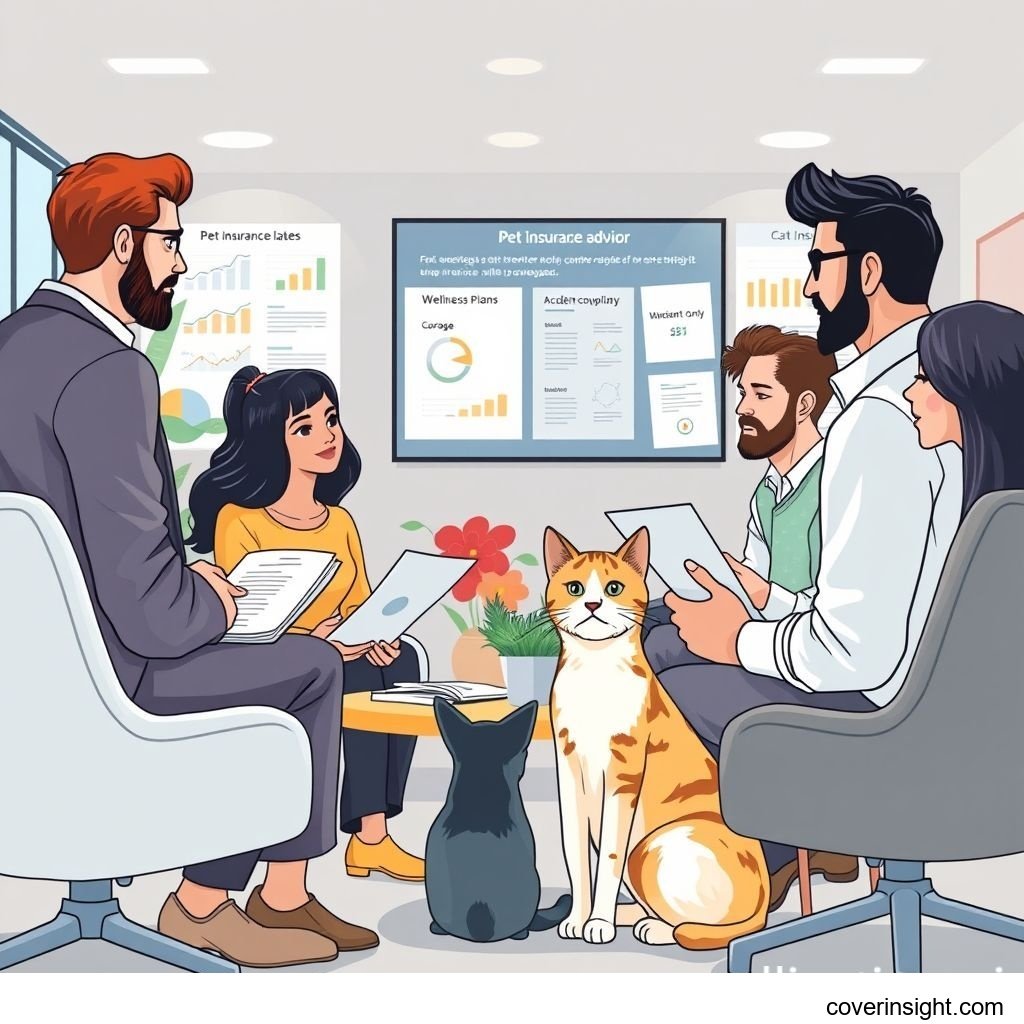Smart US Pet Dental Insurance: 2025 Guide
Introduction
In the vibrant landscape of pet ownership in the United States, our beloved feline companions are more than just pets; they're family. Ensuring their well-being often means considering every facet of their health, and dental care is a cornerstone that's too often overlooked. As we look towards 2025, the conversation around cat insurance with wellness coverage in US is becoming increasingly vital. With rising veterinary costs and the undeniable link between oral health and overall systemic health, investing in a robust pet dental insurance plan isn't just a luxury—it's a smart strategic move for responsible pet parents. Think of it as providing a safety net, offering peace of mind against unexpected, and often significant, dental expenses. For a broader understanding of insurance options available, you might want to visit our US Insurance Home.
Coverage Details
What’s Included
Smart pet dental insurance plans for 2025 are designed to cover a range of essential services that keep your cat's pearly whites, well, pearly. Typically, a comprehensive plan will include routine preventative care, often as part of a wellness add-on, covering a portion of annual dental cleanings and oral exams. Beyond preventative measures, these policies often step in when things take a turn for the worse, covering medically necessary procedures such as:
-
Dental Cleanings (Prophylaxis): Includes scaling and polishing, often requiring anesthesia.
-
Dental X-rays: Crucial for diagnosing issues below the gumline.
-
Extractions: For severely diseased or damaged teeth that cannot be saved.
-
Treatment for Periodontal Disease: Including advanced stages like gingivitis and periodontitis, which are incredibly common in cats.
-
Repair of Fractured Teeth: Depending on the cause and severity.
-
Anesthesia and Sedation: Costs associated with keeping your cat safe and comfortable during procedures.
Many plans bundled with wellness coverage will also extend to general health check-ups, vaccinations, and sometimes even flea and tick prevention, making it a comprehensive package for your cat's health.
Common Exclusions
While comprehensive, no insurance plan covers absolutely everything. It's crucial to be aware of common exclusions to avoid surprises:
-
Pre-existing Conditions: This is a big one. Any dental issue diagnosed or showing symptoms before your policy starts, or during the waiting period, will almost certainly not be covered. This is why getting coverage early is a game-changer.
-
Cosmetic Procedures: While rare for pets, any non-medical procedure solely for appearance is excluded.
-
Orthodontic Care: Braces or alignment procedures are generally not covered unless deemed medically necessary due to a specific health condition, not just for aesthetic reasons.
-
Waiting Periods: Most policies have a waiting period (e.g., 6-12 months) before dental coverage kicks in, especially for specific conditions or procedures.
-
Dietary Supplements or Non-Veterinary Products: Unless prescribed by a vet for a covered condition, these are typically not included.
-
Self-inflicted injuries: While less common for dental, deliberate harm to the animal would not be covered.
Cost Analysis
Price Factors
The cost of cat insurance with wellness coverage can vary as much as cat personalities themselves! Several key factors play a role in shaping your monthly premium:
-
Your Cat's Age: Younger cats are cheaper to insure. As they age, the risk of developing health issues, including dental problems, increases, pushing premiums higher.
-
Breed: While less impactful for dental-specific issues, some breeds are predisposed to certain genetic conditions that might influence overall wellness plan costs.
-
Your Location: Veterinary costs vary significantly by region and even by zip code within the US. A plan in a high-cost urban area will likely be pricier than one in a rural setting. For example, the cost of veterinary care in major metropolitan areas like New York City or Los Angeles can be significantly higher than in smaller towns.
-
Deductible: This is the amount you pay out-of-pocket before your insurance begins to reimburse you. A higher deductible usually means a lower monthly premium.
-
Reimbursement Percentage: This is the percentage of the covered veterinary bill that the insurer will pay after your deductible is met (e.g., 70%, 80%, 90%). A higher reimbursement percentage typically leads to a higher premium.
-
Annual Limit: Some policies have a cap on how much they'll pay out in a year. Higher limits generally mean higher premiums.
-
Wellness Add-on: Opting for wellness coverage, which includes routine dental cleanings, adds to your premium but can save you money on preventative care in the long run.
Saving Tips
Navigating the world of pet insurance doesn't have to break the bank. Here are a few smart tips to keep costs down:
-
Enroll Early: Insuring your cat when they are young and healthy is arguably the best strategy. You'll avoid pre-existing condition exclusions and benefit from lower premiums.
-
Compare Quotes: Don't just settle for the first quote you get. Visit several reputable providers and compare their coverage, deductibles, reimbursement rates, and annual limits. Look at what’s truly on offer, not just the sticker price.
-
Adjust Deductible and Reimbursement: If you're comfortable taking on more initial risk, opting for a higher deductible can significantly lower your monthly premium. Similarly, a slightly lower reimbursement percentage (e.g., 80% instead of 90%) can also reduce costs.
-
Look for Discounts: Many providers offer multi-pet discounts, military discounts, or even discounts for bundling policies. Some employers also offer pet insurance as an employee benefit.
-
Understand Your Needs: Do you need comprehensive coverage for every sniffle and scratch, or are you primarily concerned with catastrophic dental events? Tailoring your plan to your actual needs can prevent you from overpaying. For general guidance on insurance, you might find resources at Insurance Resources Global.
FAQs
How much does cat insurance with wellness coverage cost?
The cost of cat insurance with wellness coverage in the US can range widely, typically from $30 to $70 per month, but can go higher for older cats or very comprehensive plans. This range often includes basic accident & illness coverage plus a wellness add-on that covers routine dental cleanings and other preventative care. A routine dental cleaning for a cat in the US, according to estimates from veterinary associations, can range from $300 to $700, and if extractions or advanced care for periodontal disease are needed, costs can easily skyrocket to $1,000-$3,000 or more, making that monthly premium seem like a real bargain.
What affects premiums?
As discussed earlier, several factors influence your premium. These include your cat's age, breed, your geographic location, and the specifics of your chosen plan (deductible, reimbursement percentage, annual limit, and whether you include a wellness add-on). Think of it like auto insurance; the older the car, the more miles, the more likely something might go wrong, hence higher premiums.
Is it mandatory?
No, pet dental insurance is not mandatory in the United States, unlike auto insurance in most states. It’s a voluntary choice made by pet owners to help manage the financial risks associated with their pet's health care. However, as the American Veterinary Medical Association (AVMA) highlights, periodontal disease is the most common clinical condition in cats, affecting more than half of all cats by age three. This statistic alone underscores the importance of considering coverage, even if not legally required.
How to choose?
Choosing the right plan can feel like finding a needle in a haystack, but it doesn't have to be. Start by researching reputable providers. Check reviews and ratings from other pet owners. Most importantly, read the fine print of the policy documents carefully, paying close attention to exclusions, waiting periods, and how claims are processed. Don't be shy about calling their customer service with any questions—a good insurer will be transparent and helpful. You can also verify the legitimacy of insurance providers through resources like the National Association of Insurance Commissioners or your specific State Insurance Departments.
Consequences of no coverage?
Without pet dental insurance, you're on the hook for 100% of your cat's veterinary bills. This can lead to significant financial strain, especially for unexpected emergencies or chronic conditions. Take the case of Sarah, a cat owner in Ohio. Her beloved Siamese, Luna, developed severe periodontal disease at just five years old. Without insurance, the estimated $2,500 bill for multiple extractions and advanced care would have been a real punch to the gut. Thankfully, her pet insurance, which included wellness and dental, covered 80% after her deductible, turning a crisis into a manageable situation. Without coverage, you might face tough decisions about your cat's care based on your budget, not what's best for their health, potentially leading to prolonged suffering or even difficult choices about euthanasia. It’s truly a situation where an ounce of prevention is worth a pound of cure.
Author Insight & Experience
As someone living in the US and having navigated the ups and downs of pet ownership, including unexpected veterinary bills, I can tell you this: investing in pet dental insurance, especially with wellness coverage, has been a no-brainer for my family. Based on my experience, the sheer relief of knowing that a sudden, expensive dental procedure won't send you into a financial tailspin is worth its weight in gold. It allows you to focus on your cat's recovery and well-being rather than stressing over the invoice. It’s not just about saving money; it’s about providing the best possible care for your furry friend without compromising your financial stability.








Comments